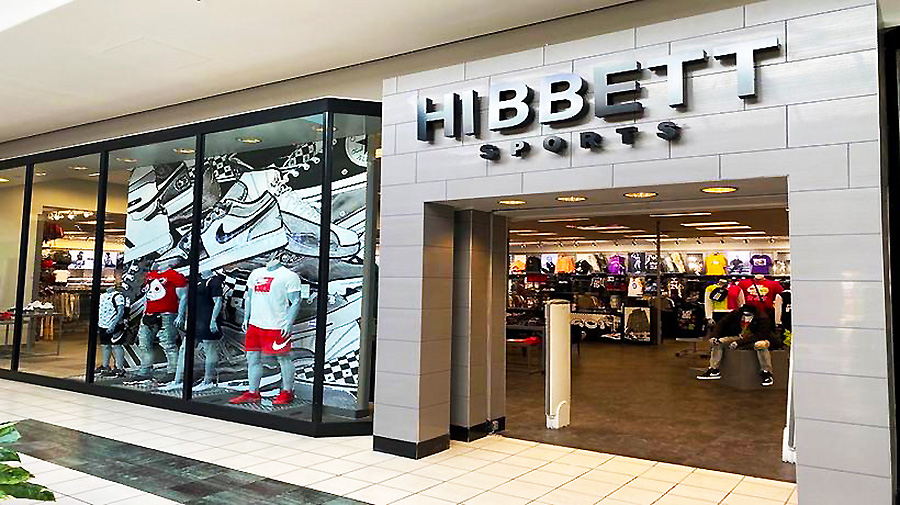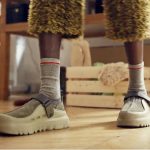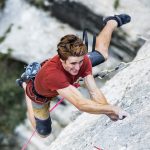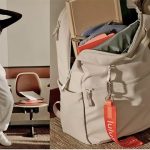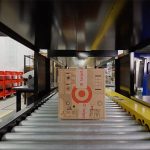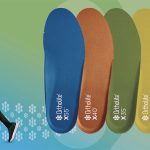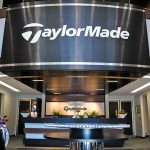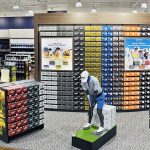Fiscal year 2025 became the year that JD Sports Fashion Plc saw the U.S. market become the largest revenue region for the global active lifestyle retailer. The UK-based retailer, parent of the JD, Hibbett, Shoe Palace, and DTLR retail brands in the U.S. market, and primarily JD Sports (or the recently acquired Courir) globally, reported that fiscal 2025 full year organic sales increased 5.8 percent and like-for-like (LFL, comp-store, same-store) sales growth of 0.3 percent year-over-year (y/y) Constant-currency revenue growth was 12.0 percent to £11.5 billion in fiscal 2025 ended February 1, 2025.
JD Sports Fashion Plc reports in the British pound (£) currency.
“We increased Group revenue on a constant currency basis by 12 percent with organic sales growth of ~6 percent, more than double the market growth, thanks to our strong and agile, multi-brand model,” offered Régis Schultz, CEO, JD Sports Fashion Plc. “We delivered a 48 percent gross margin, excluding the impact of acquisitions, which was in line with the previous period due to our full price commercial strategy and strong trading discipline in a promotional market. We concluded two important acquisitions in our key strategic markets – Hibbett in the U.S. and Courir in Europe – while we continued to invest in our infrastructure and controls environment. In constant currency, our operating profit was ahead of last year and our operating cashflow was over £1.2 billion, demonstrating our strong cash generation. We achieved Profit before tax and adjusting items* of £923 million, in line with our January guidance.
Fiscal 2025 Summary
Revenue for fiscal 2025 amounted to of £11.5 billion, a 10.2 percent y/y increase on the comparative 52-week period, in what was described “again a volatile market.”
LFL sales growth was 0.3 percent and there was a 5.5 percent benefit from new stores, leading to organic sales growth of 5.8 percent. This organic sales growth exceeded estimated market value growth of 3.8 percent in 2024, meaning the company said it again outperformed the market organically.
“A key element to our ability to outperform the market consistently is the strength and agility of our multi-brand model,” Schultz suggested. “We have a consistent focus on offering our customers the brands and products that they want, which means we need to move quickly at all times to adapt to changes in fashion.”
Region Summary
All regions grew revenue in the period other than the UK, which was impacted principally by non-core divestments made over the last two years.
- The UK declined 4.1 percent to £3,205m.
- Europe revenue increased 9.5 percent to £3.5 billion, including two months of Courir.
- North America revenue increased 27 percent y/y to £4.2 billion including six months of Hibbett.
- Asia Pacific revenue*increased 0.4 percent to £501m, as the exit of non-core businesses in the year reduced revenue by £30m (c.6 percent).
“Growth in our newer markets resulted in a better business balance geographically with North America generating 37 percent of revenue, Europe 31 percent, the UK 28 percent and Asia Pacific 4 percent,” Schultz shared.
Channel
Retail stores grew revenue by 15.7 percent y/y to £9.1 billion with Online (E-Commerce) channel declining by 2.9 percent y/y to £2.25 billion, said to reflect the continued shift back to pre-pandemic online participation, the company’s focus on online profitability and its investment in stores.
Stores now represent 79 percent of revenue and Online is 20 percent, with Other, mainly gym memberships, at 1 percent.
“With our focus on customer satisfaction, we are consciously channel agnostic, facilitating the flexibility we need to meet customers’ individual purchasing requirements, whether it be buying in store, buying online and delivered to home, or buying online and delivered to store,” Schultz noted.
Category
Footwear continued to perform strongly in fiscal 2025 with revenue growth of 15.2 percent y/y to £6.82 billion
Apparel revenue grew 4.2 percent y/y to £3.55 billion, reportedly driven primarily by mostly footwear-focused acquisitions.
Accessories revenue grew by 4.8 percent y/y to £702 million for fiscal 2025.
“This means we continue to build a good mix of products delivering a ‘head-to-toe’ shopping opportunity with footwear at 60 percent, apparel at 31 percent and accessories at 6 percent of revenue,” Schultz shared. “Other” was said to be 3 percent of the revenue and includes outdoor living equipment and gym memberships.
Profitability & Expenses
- Gross margin came in at 47.8 percent of revenues in fiscal 2025, said to be down slightly on the prior period reflecting the acquisitions of lower margin Hibbett and Courir.
- Constant-currency operating profit before adjusting items after interest on lease liabilities was up 0.8 percent y/y.
- Profit before tax and adjusting items of £923 million was down 4.0 percent y/y, reportedly due largely to the continued investment in infrastructure, controls and security.
- Profit before tax amounted to £715 million in FY 2025, down 11.8 percent y/y, said to be due partly to an increase of £53 million in adjusting items.
- Basic earnings per share down 9.1 percent to 9.50p. Adjusted basic earnings per share were down 3.3 percent to 12.39p
- Operating cashflow net of lease repayments of £1.25 billion driving net cash before lease liabilities of £52 million.
Store Summary
JD Sports Fashion ended fiscal 2025 with 4,850 stores worldwide, 1,533 more than at the start of the period, due primarily to the acquisitions of Hibbett and Courir, which added 1,485 stores.
Across all retail brands, 311 stores were opened and 263 stores were closed, including 66 from Finish Line and Macy’s as the company continued to rationalize its store portfolio.
“We also converted 29 stores to JD from Finish Line in the U.S. and a further 21 to JD from other European fascias,” the CEO said. The company will eventually convert all Finish Line doors to JD doors.
2026 First Quarter Summary
Trends for the 13-week period ended May 3 were said to be “in line with our expectations,” according to a statement from Schultz.
- Organic sales growth was 3.1 percent, driven by a 5.1 percent contribution from new space.
- LFL (comp store) sales were down 2.0 percent.
- Gross margin was said to be in line with the prior period, both reflecting the company’s disciplined commercial approach in what continues to be a volatile and promotional market, particularly online.
- All regions achieved organic sales growth in the quarter.
“In line with our JD First strategy, the JD segment drove Group sales growth through our store rollout programme across Europe and North America, achieving growth of 4.7 percent in the quarter,” Schultz noted.
- North America saw organic sales growth of 1.4 percent, reflecting in part a shift in the product launch schedule compared with last year.
- Europe delivered organic sales growth of 6.5 percent.
- The company is seeing “an improving trend” in the UK, helped in part by good weather.
- Gross margin was 48.2 percent, said to be in line with the prior period.
- On an organic basis, excluding the impact from the acquisitions of Hibbett and Courir, gross margin was 48.6 percent, up 40 basis points versus the prior period, reflecting a continued disciplined trading approach.
CEO Schultz said the recent announcements in respect of tariffs continue to evolve and the Group is monitoring the position carefully. Elevated tariffs have the potential to impact the Group in three areas: –
Global economy and customers. The potential impacts are on consumer confidence and, in the short term, the cost of goods and services for US customers may rise to some degree with a potential impact on overall. consumer demand.
Schultz said they consider this to have the largest potential impact on the Group.
Our brand partners. They source most of their products from South East Asia. We expect mitigating actions to be taken across the supply chain to ensure that prices remain as competitive as possible for consumers.
Goods and services not for resale, such as store fixtures and fittings, and the JD brand and licensed products.
These products represent less than 10 percent of total Group revenue and are sourced from a wide range of countries. We have modelled the potential impact of tariffs on the Group and it is not considered to be material.
Still, Schultz said they are taking action to mitigate any potential impact through further diversifying the range of countries from which JD sources own brand and licensed products, continuing to work closely with the company’s brand partners and ongoing cost control.
“In summary, we have traded in line with our expectations in the first quarter. The market remains volatile and visibility on the overall potential impact from tariffs is low,” the CEO commented. “Our strong and agile multi-brand model positions us well to navigate these market conditions and we are focused on controlling our cost base and delivering on the key strategic projects that underpin the delivery of improved shareholder returns over the medium term.”
Outlook
Overall trends in the first quarter of the new financial year was said to be in line with company expectations in a volatile market.
“Despite this volatility, and uncertainty surrounding the impact of U.S .tariff changes, we look forward into the medium term with confidence that we can continue to outperform the market, improve our profit margin and create significant value for our shareholders,” Shultz commented.
While cautioning that the U.S. Trump Tariffs could lead to some higher prices in the market, the company said it may weigh on demand in the market.
Reuters said Wednesday the company is facing “headwinds from a competitive and volatile market, worries over consumer spending and a drop-off in demand for Nike products, which account for 45 percent of its sales.”
The combination of the weaker first quarter, the potential for negative consumer responses to potential price increases and headwinds from an uncertain market all combined to push JD Sports Fashion shares down more than 8 percent on the London Stock Exchange on Wednesday, May 21.
Image courtesy Hibbett Sports/JD Sports Fashion Plc

